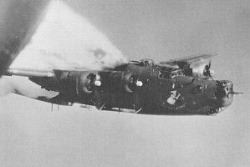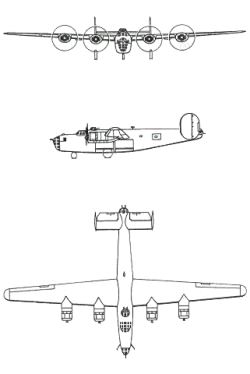| B24 Liberator
by Jim "Twitch" Tittle |
||||
|
Always recognized, but never as well known as the B-17 was the fate of the Consolidated B-24 Liberator. This excellent bomber took to the air in late 1939, four and one half years after the fabled Flying Fortress prototype. The Liberator was the name the British bestowed upon their Lend-Lease B-24s and the U.S.A.A.F. adopted it soon after. A LATE START Though the B-24 got a later start, production surpassed that of the B-17 and all other American combat aircraft. 18,188 machines were built between 1941 and 1945. The Davis high-lift airfoil offered less drag, higher lift and less wing loading than conventional designs. Furthermore, the tricycle landing gear and high shoulder mount wing position offered fuel accommodation and maximum bomb stowage. The Liberator was designed to carry 8,000 lb. of bombs but the normal load was 5,000 lb. to make the longer missions possible. A short haul max was 12,800 lb. The super secret and super accurate Norden bomb-site was housed in the extreme nose section below the turret. Whether in the B-17 or B-24, the Norden was touted to be "pickle barrel" accurate. It must be realized that only one in five level bombers' bombs hit its target. ORDNANCE GALORE The 600 r.p.g. nose and 525 r.p.g. tail turrets were features the B-17 did not have. The nose and tail turrets, offered larger fields of track and fire. . The nose turret began with the "J" model. In all, ten .50 caliber Brownings were carried in the nose, tail, ventral and dorsal turrets plus the waist positions on the sides. The first "D" carried a single .50 in the nose with 200 rounds and the dorsal and tail turrets with 400 r.p.g. The "J" culminated the series with the ten guns and a whopping 4,716 defensive rounds. The First Strategic Attack B-24s mounted the first real strategic attack by the U.S.A.A.F. in WWII . Flying from Egypt to Bulgaria and the Ploesti oil fileds in June of 1942, the thirteen bombers did little damage but surprised the enemy by arriving from an improbable direction. The next Ploesti raid was a year later in August, 1943 and 177 Libs arrived over the target after low level ingress from Libya carrying 5,000 lb. of incendiaries and 3,100 gallons of fuel for the 2,700 mile round trip. Most of the fifty seven aircraft lost were to AAA over Ploesti. The damage dealt was soon repaired. It was not until late in the war that Ploesti output was severed after continual attack. On Black Thursday October 14, 1943 the 60 B-24s that were to take part in the ill fated Schweinfurt raid never were able to assemble due to heavy clouds and ended up attacking the diversionary target of Emden. Only 29 aircraft, escorted by Thunderbolts, made the attack without loss of aircraft. Many Roles Anti-submarine duties were soon in the offing on both sides of the Atlantic by both R.A.F. Coastal Command and U.S.A.A.F. operations beginning in 1943. B-24s ultimately became the scourge of the U-boats when later upgraded with better radar. In the Pacific by 1943 B-24Ds had almost completely replaced the B-17 as the standard long range heavy bomber. The theater there did not lend itself to massive formations as did the European where the effort was against industrial targets and population centers. |
 Until the B-29 arrived to take the war to the home island of Japan, bombing raids were more surgical in nature in the Pacific islands. Smaller, hardened targets were the routine where dive bombers and fighter-bombers excelled. Prone to catch fire from superficial strikes and lacking in defensive armor, the B-24 faired better in the Pacific where flak was thinner and enemy interceptors were generally lighter armed than Luftwaffe counterparts. This is not to allude that the Liberator did poorly over Germany. The B24 J The B-24 J was built in the largest numbers of any model with 6,678 examples. At the height of strength the U.S.A.A.F. operated 6,043 Liberators by September, 1944. It was designated Liberator "B" by the British. Canada, Australia, and South Africa used it as well. Photo recon versions with up to eleven cameras were dubbed the F-7-F0. The U.S. Navy "Js" were designated PB4Y-1s for its successful anti-sub operations.
 Power came from four Pratt & Whitney fourteen cylinder air cooled radials. Using the "J" model as a representative model of the type, its P&Ws were the R-1830-65 with the General Electric exhaust driven turbo-supercharger developing 1,200 h.p. @ 2,700 r.p.m. The XB-24K was the result of the decision that improved control and stability would be achieved with a single vertical stabilizer. In production it was to be called the B-24N. It improved climb speed by 11 m.p.h. While the April 1944 decision to make future Libs single tailed, the actual production line change-over order came too late in the war to see any arrive in combat areas. The Navy did benefit with the PB4Y-2 Privateer single fin Liberator. It featured a sleeker nose turret, an additional Martin dorsal turret aft of the trailing edge of the wing and two Erco waist blisters. With twelve .50 caliber guns and the improved tail, this was the ultimate Liberator. It served with the U.S. Navy well into the 1950's. Join a discussion forum on this article by clicking HERE.
|
|||
|
Copyright © 1997 - 2000 COMBATSIM.COM, INC. All Rights Reserved. Last Updated September 22nd, 1999 |
||||
